Productive performance, rumen volatile fatty acid profile and plasma metabolites of concentrate-supplemented Bach Thao goats in Vietnam
引用次数: 0
Abstract
Twenty-five Bach Thao bucks (7 months old and 20.9±0.3 kg BW) were used to quantify the effect of concentrate supplementation on growth performance, rumen volatile fatty acid profile, digestibility and plasma metabolites. Goats were allocated into five treatment groups of varying levels of concentrate supplementation: Control (ad libitum access to elephant grass), 0.6% C (control plus 0.6% of concentrates), 1.2% C (control plus 1.2% of Concentrates), 1.8% C (control plus 1.8% of Concentrates) and 2.4% C (control plus 2.4% of Concentrates) as a percentage of liveweight on a dry matter basis. Growth and feed intake were measured in a 6 week feeding trial period after 3 week of initial adaptation. In vivo digestibility was assessed in the 10th week by the total faecal collection method. There were significant increases in average daily gain (ADG), feed intake and digestibilities of dry matter (DM), organic matter (OM) and crude protein (CP) as dietary concentrate levels increased. However, digestibility of neutral detergent fibre (NDF) was not different between the concentrate-supplemented groups. Pre-feeding ammonia concentration in rumen fluid was not different between treatments, but 4hrs after feeding, significant differences were detected. The values of ammonia ranged from 100-200 mg L⁻¹ at both times of measurement. Rumen fluid pH values were not different 4hrs post-feeding. Volatile fatty acid concentrations of propionate and butyrate increased with increasing levels of concentrates consumed, in contrast to decreased acetate concentration. This study clearly demonstrated that increasing concentrate levels offered to Bach Thao bucks up to 1.8% of live weight on a DM basis resulted in the greatest improvement in ADG, feed intake and nutrient digestibility, thus, confirming the tested hypothesis that increased level of concentrate supplementation will improve productive performance of goats without an adverse effect on rumen fermentation and nutrient digestibility.越南精料添加巴赫邵山羊生产性能、瘤胃挥发性脂肪酸分布和血浆代谢物
选用25头7月龄、体重20.9±0.3 kg的巴氏雄鹿,量化添加精料对其生长性能、瘤胃挥发性脂肪酸谱、消化率和血浆代谢物的影响。将山羊分为5个精料添加水平不同的处理组:对照(随意取用象草)、0.6% C(对照加0.6%精料)、1.2% C(对照加1.2%精料)、1.8% C(对照加1.8%精料)和2.4% C(对照加2.4%精料)(按干物质基础计算)。初试期3周后,在6周的正试期内测定生长和采食量。第10周采用全粪收集法评估体内消化率。随着饲粮精料水平的升高,平均日增重(ADG)、采食量以及干物质(DM)、有机物(OM)和粗蛋白质(CP)的消化率均显著升高。而中性洗涤纤维(NDF)消化率在精料补充组之间无显著差异。饲喂前各组间瘤胃液氨浓度差异不显著,但饲喂后4h差异显著。在两次测量中,氨的值在100-200 mg L - 1之间。饲喂后4小时瘤胃液pH值无差异。丙酸和丁酸挥发性脂肪酸浓度随浓缩物消耗水平的增加而增加,而乙酸浓度则降低。本研究清楚地表明,以日增重为基础,将精料添加水平提高至巴赫雄鹿活重的1.8%时,平均日增重、采食量和营养物质消化率的改善最大,从而证实了试验假设,即增加精料添加水平可以提高山羊的生产性能,而不会对瘤胃发酵和营养物质消化率产生不利影响。
本文章由计算机程序翻译,如有差异,请以英文原文为准。
求助全文
约1分钟内获得全文
求助全文
来源期刊
自引率
0.00%
发文量
0
审稿时长
1 months
期刊介绍:
Journal of Animal Veterinary advances is a peer-reviewed, open-access scientific journal which publishes articles related to experiments, treatment, analysis, biological elements and other methods of research connected with veterinary. JAVA started publishing activity in 2002, since that time is updated twice a month, and is available in online and print formats. The publications are reviewed by Editorial Board in accordance with the standards and novelty of the subject, while strictly following ethical guidelines. Subject areas suitable for publication include, but are not limited to the following fields :: Veterinary science :: Animal husbandry :: Animal nutrition :: Anatomy :: Biological science :: Pathology :: Infectious diseases :: Animal physiology :: Animal breeding :: Animal biotechnology :: Transgenic animal production :: Animal parasitology :: Veterinary medicine :: Animal feed and nutrition :: Equine.

 求助内容:
求助内容: 应助结果提醒方式:
应助结果提醒方式:


